Once there was a thriving costume community showing their work at hundreds of conventions all over the country. In order to help support and promote these conventions, and make it easier for convention-goers to find them in a time without internet, nationwide lists of conventions, with their dates and locations, printed in dot matrix on pin-feed paper, were posted on the walls of many convention venues. This list was also helpful in ranking the size of conventions, as costumes would be “tried out” at smaller conventions, refined, and presented again at larger conventions, often with the end goal of competing with an amazing final product at the biggest convention of them all: Worldcon.
As the costumers’ collective skill level grew, their costumes became intimidating to some. There were those who wanted to be in the masquerade but were too overwhelmed by the work they saw on stage. They thought they could never produce anything good enough to have any chance of showing well, let alone of winning any prizes. The costume community responded by creating a division system in order to be more inclusive of everyone who wanted to make costumes. It didn’t matter if you were completely unskilled, possessed with preternatural skills, new to the art, or a seasoned veteran. You would compete only against others of your skill level and division—whether you were doing a re-creation or original work. There was no jury system. If you wanted to show, you showed. All were welcome and encouraged. As many awards as needed, each with descriptions as seemed necessary, were given to describe the masquerade. Backstage there were repair kits and food and water and straws to get the water into those who were in restrictive costumes, which a goodly portion of them were.
These talented costumers drew from everything for inspiration. Vintage theater and fashion prints, Japanese anime culled from fuzzy UHF TV stations or magazines, science fiction movies, books, poetry and more. They created costumes in an era that had little problem with nudity, with little more than an idea, and a lucky find of an odd bolt of green lamé at their local fabric store. Many became skilled patternmakers because there were no patterns for what they were doing. They had no access to sergers, or the internet, or video recordings to loop the same 4 seconds endlessly while searching for details to make their screen-accurate re-creation costumes—and they were very intent on looking as if they had stepped directly off the screen. They went to see the movie dozens of times, if they had to, just to see the back of the costume, or the details of the arm insignia. They snuck in their 110 cameras and took pictures of the screen and waited a week for the prints. They contacted the artist who painted the picture they were using. They had to be very creative about finding information about the re-creations they were making. Their original work sent them to New York City or Los Angeles garment districts to find suitable materials with which to build their costumes.
There was no industry around them to support their work, nor were there any “cos-famous”. These costumers found their community quite often by accident; being dragged to a convention by a friend, or coming to the convention for some other reason and stumbling across the masquerade. They came because they loved making beauty. There was not even the glimmer of the idea that one would or even could become famous with costuming. They all just had the burning need to build gorgeous, amazing, stage-filling costumes. After all, if you could wear your costume comfortably for more than 15 minutes, then it was not a competition costume, it was a hall costume. They had their heroes. They had aspirations to be like Adrian Butterfield and Victoria Ridenour, Karen Schnaubelt and Kelly Turner, Sally Fink, George Paczolt or, Kathy and Drew Sanders—some of the top costumers of the time. They chatted on APAs, and formed costuming guilds all over the country, most under the umbrella of the International Costumer’s Guild.
Over the years, with this system in place, masquerades ballooned to include hundreds of entries and lasted three hours or more, even with the necessary strict time limit imposed on each entry. Often these costumes took a year or more to build. This show of the overwhelming love of the art that these costumers had was not limited to the larger conventions, but was true at the smaller local conventions as well. They too were hours long and filled the ballrooms to beyond capacity with spectators. Judging often took another hour or more. At one convention which had a strong core of dedicated costumers, there was even the question of whether to move the masquerade from the first night of the convention to the prime Saturday night spot in place of the much loved art auction, so as to be the main event of the convention. Eventually, the media found these costumers, and coverage of the conventions became a yearly staple at local television stations, as a quaint report on local color.
Wanting even more costuming, these artists made their own convention. Karen Schnaubelt, another of the top costumers, was instrumental in the creation of that convention, Costume-Con, which she still owns. Costume-Con was created in order for the costumers to learn from each other and have more masquerades in which to compete. For some costumers, it was more of a draw than Worldcon. It was, and is still, fabulous. Costumers would engage in what was known as the “costumer’s pick” where—a fabulous costume being spotted in the halls—a small horde of costumers would descend upon that hapless costumer, picking up hems, examining beading or fabric or headpiece all while blasting her, rapid fire, with questions about how it was made. It was the ultimate compliment, to be “asked” in this manner to share how it was done. Events and classes and panels filled the day and the masquerades filled the evenings—every evening: The Science Fiction and Fantasy, Historic, and Future Fashion Folio each had their own night. Costumers roamed the halls in amazing creations of all types. It was, and still is, the convention for showing costumes.
Word of this costuming community continued to grow and in 1992 Thomas Boswell of Lark Books put together a wonderful coffee table book of their work called “The Costume-Maker’s Art: Cloaks of Fantasy, Masks of Revelation.” Most of the photos in this book are Photographer Linda Sweeting’s work. She was always there with her roll of blue seamless paper, providing professional photos of the work. Some of the same work that they put in their costume competitions ended up in books of other genres as well, like “Fiberarts Design Book Four” by Nancy Orban, a juried book of fiberart. A good number of these costumers had also honed their skills enough to find work in theater, and so careers were made from a hobby, with costumers landing at the Guthrie, the Folger, and more.
Then the economy slowed enough to have a noticeable effect on much of the costume community’s output. Money got tight, and travel with large costumes was expensive. Masquerades dwindled to a shadow of the creative storms they once were. Things were changing, and the costume community knew that what they had been a part of was still akin to a secret society when it came to the rest of the world. They knew that the work was amazing, should not be forgotten, and simply had to be preserved. It was too incredible to let it all disappear into obscurity. It was a big job, as most of the art world considered costumes “craft”, so there was no real place to record that work. There was nothing for the costumers to do but to make their own place to store their history.
Carl Mami had already been videotaping many of the masquerades and providing costumers with the video records of their work. After Costume-Con 3 Marty Gear, our beloved masquerade MC, and his wife Bobbie hosted a convention wrap party. It was here that Carl offered start an archive. With his own library of videos as the heart of the collection, he tracked down more photos and videos from as far back and far away as he could. It was a time lacking email and digital cameras, so Carl travelled to copy people’s photos and their videos. The collection grew to fill large portions parts of Carl and his wife Elaine’s house, and was for the most part funded by himself. When Carl’s eyesight began to fail, costumers extraordinaire Pierre Pettinger, Bruce Mai, and Nora Kathleen Schneeberger Mai, along with the ICG, carried on with his documentation work. A spot was even secured for it in the Library of Congress. Now it is funded by the IGC and is named for the extraordinary costumers Pat and Peggy Kennedy, while Carl was recognized with a Lifetime Achievement Award. As old work surfaces and new work is produced, it is added to the collection.
As the number of masquerade entries here were dwindling, the Japanese report about the 1984 Los Angeles Worldcon Masquerade by Nobuyuki Takahashi, president of Studio Hard, had headed back to the west on the heels of the new influx of Japanese Anime to America, and the attendant anime conventions.
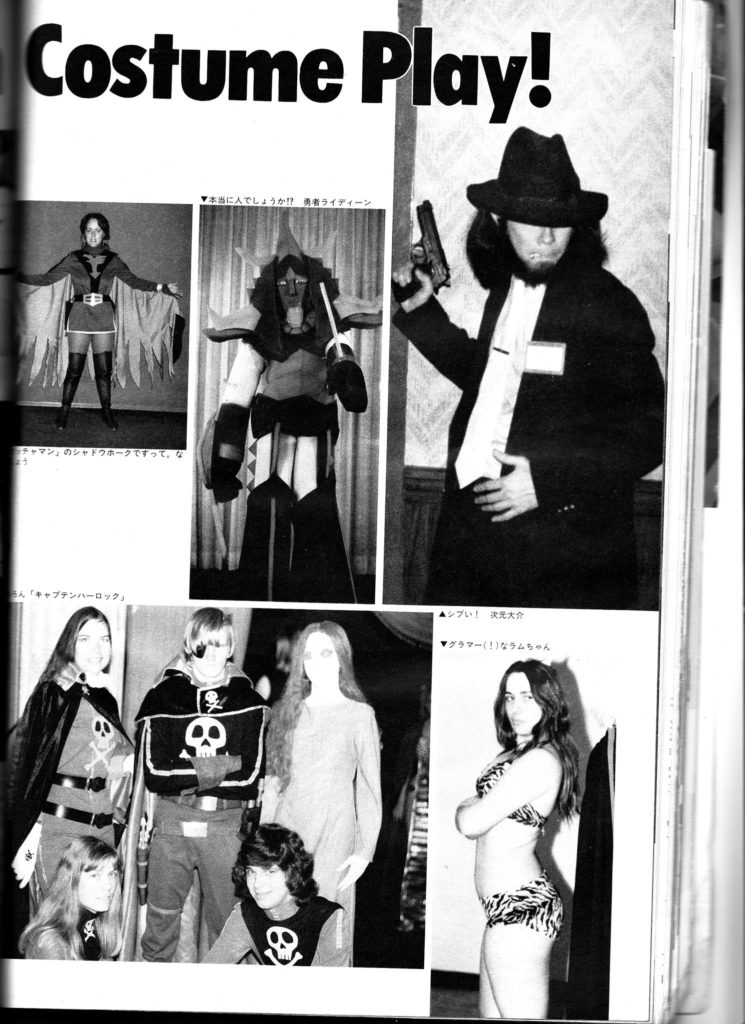
“This is a page from an article in ANIMAGE magazine (March 1985 issue), published in Japan. 2-page article, all Western costumers, labelled “Costume Play” (“cosplay” had obviously not come into common use yet). Some of the photos were taken 4 and 5 years prior to publication of the article. Whatever the origin of the word, dressing up as one’s favorite characters from anime and manga was still obviously a novelty at the time this was published. Another Western influence may have been when a bunch of L.A. fans went to an early 1980’s (May 1986) DaiCon in Japan, including at least one fan who participated in the costume contest. She looked so much like the character she was portraying that one obsessed Japanese fan stalked her through the entire convention.” —Karen Schnaubelt Karen can be seen in the standing in the left side of the lower left picture in the “Space Pirate Captain Harlock” costume set and in the top right page above in the “Space Ship Yamato” costume set.
Worldcon 1984 was near the height of the grand masquerade events, and the costumers there made quite an impression on him. He wrote an article about them for his Japanese audience, and while not understanding what he was seeing, he coined a word anyway to try to explain it all to his readers. He called it “cosplay”, and so he brought this American art form to Japan, where it took root in their world of Anime.
In the mid 80’s America was also discovering the fabulous world of Japanese animation—that is, the animation that was “Kimba the White Lion”, “Marine Boy” and “Speed Racer,” and if we were lucky “Space Battleship Yamato,” that we often watched on our fuzzy UHF television channels. There weren’t any anime conventions yet, but local science fiction and comic conventions were beginning to see important Japanese anime guests. There were clandestine copies of fan-subtitled copies of Miyazaki films showing up, viewed with a select few, huddled in a friend’s basement, or without the fan-subtitles, but accompanied by printouts of the translations that you read alongside watching the movie. When anime finally got its own North American conventions a whole new crop of people were drawn to them and they got word of this “Japanese” thing called “cosplay”. New anime with both subtitles and dubbing showed up on our movie screens at an increasingly rapid pace. Anime conventions appeared, and the new anime fans costumed there as their favorite characters, calling it what the Japanese costumers had called it because they had no idea that it was not Japanese at all.
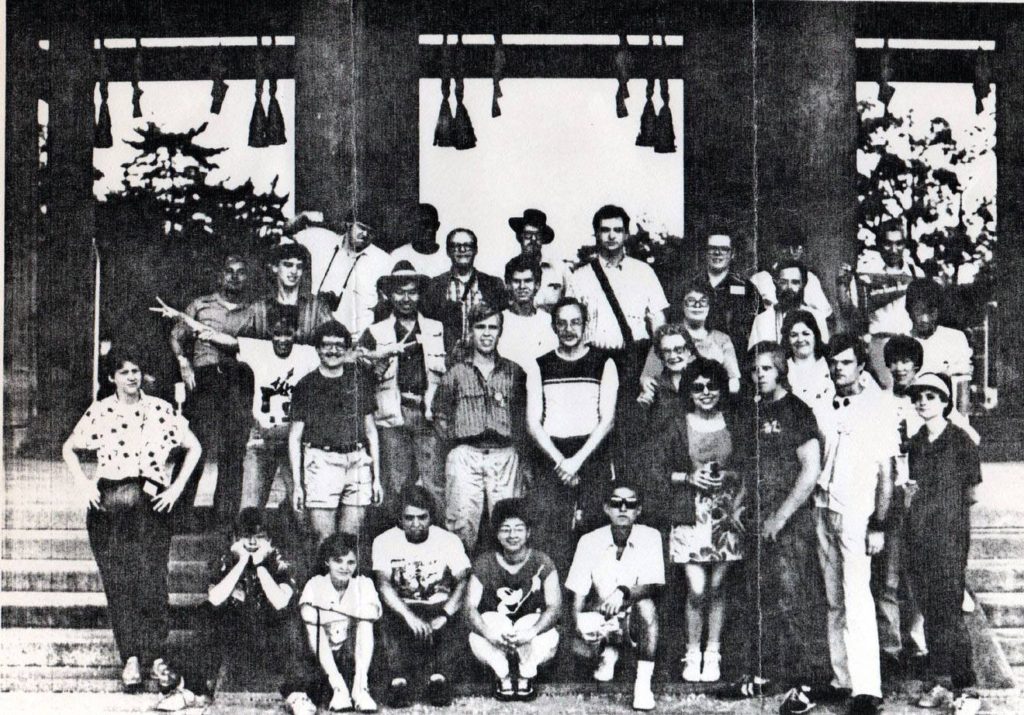
Anne Cronin’s May 1986 two-week tour of Japan, which included a stop at an Anime convention. Photo: Anne Cronin
Originally, cosplay was simply about wearing a costume derived from Japanese animation. You didn’t have to make it. You were just having fun wearing it. There were vendors out there on ebay, and Amazon, often from Japan, selling ready-made anime costumes. Then came those that wanted bigger and better costumes, or wanted something no one else was wearing. So, like the costuming community just “next door” had been doing for decades at the science fiction conventions, these anime fans set to making their own.
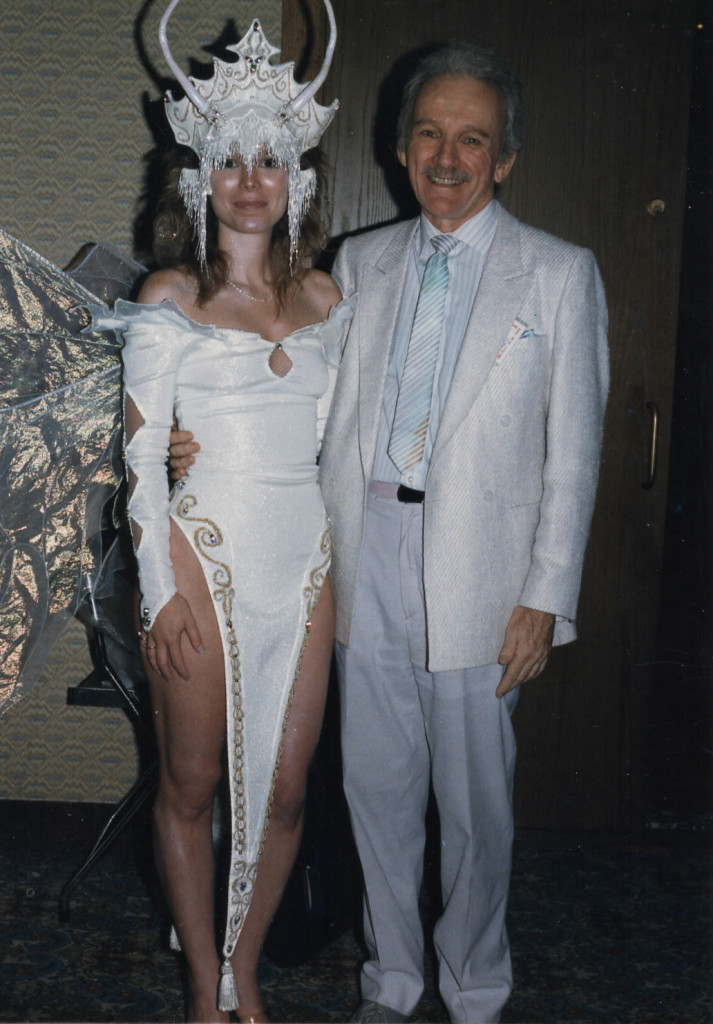
William Ware Theiss and myself from about 1991. The same year a random gentleman asked me why I costumed. Photo: Bob Pinaha.
As Japanese anime gained footing in mainstream America and the anime masquerades grew in size, the costumers and cosplayers discovered each other’s conventions. However, the cosplayers had no experience with the way the costumer’s masquerades were run, and the costumers expected the same rules at anime conventions that they had known for over a decade. There was a lot of confusion, and quizzical looks, and worse.
As the word “cosplay” was picked up by the press and reality shows, it gained traction and began to take on the same meaning as what had been until then called “costuming”. The definition of “cosplay” has been a moving target ever since. Not even the cosplayers can agree on the definition. Some say it’s anime costumes only. Some say all media-related costuming. Some say all costuming. Some come to costuming conventions and call the costumers they see there “cosplayers,” which many refuse to answer to, seeing no reason to rename their body of work. Costume artists start small businesses with the word “cosplay” in them, whether they make original costumes or copies of designs from media. The word really has no firm definition yet.
Now a whole industry has sprung up around the anime conventions and their costuming. Fabrics, special patterns, and magazines are marketed toward them. The general public, who are often quite clueless, only knows “cosplay”, because of the media coverage, and conflates the two. They didn’t get it then, and they don’t get it now, new nifty portmanteau or not.
I was one of those costumers, back in the 70’s, 80s and 90s. I have a pretty good portfolio of costumes from that time, nearly all award winners. I put everything into them, and enjoyed television coverage, printed press coverage, and inclusion in juried books of costume and fiber arts. My first convention set me on my path to my choice of college degree: Apparel Design. I found work in the theater, and helped another costumer do the same. I went on to garner several nominations and a win for best costumes for my own theater work. Costuming has always defined who I am.
At a convention in 1991 a gentleman in a business suit walked up to me and asked me why I “did this”. I could only sputter “For the same reason you breathe.” He looked at me in an odd way, smiled, guffawed, nodded, and that was that. It was clear that he had considered costumes “not worthy” of so much work, but he saw that I did. Even though the word hadn’t made it back to North America yet, it was just “cosplay” to him—something not noble, not worthy of the time it took to create it, even though some of the creations were absolutely worthy of the finest Broadway plays or big budget films.
And so, momentum of the new “cosplay” word grows. The newer, younger crowd makes original work, but since they came to costuming by way of Anime, they still call themselves cosplayers. Cosplayers brand themselves as such, finally showing up on reality shows, and the media is just frantic for them. Most have no idea that this cosplay thing is not Japanese at all. It’s American, misnamed by a Japanese man searching for a name that was not “too noble” for the art he saw at Worldcon in 1984. As one who has never cosplayed, “even once”, it’s understandable how Mr. Takahashi just got it so completely wrong, and completely missed all the subtlety and cultural nuances of what he saw. No outsider could, let alone one from a totally different culture.
Now, as ‘cosplayers’ enjoy their turn at being the darling of the internet, there have been skirmishes about what to call these people who make costumes for conventions. Is it “cosplayer” or “costumer”? Sometimes you hear that one should simply respect a person’s wishes, and call each what they ask to be called. Then you also get the positively rabid insistence from some that it’s all cosplay, and only cosplay, and anything else is somehow insulting to cosplayers. They are absolutely, positively emphatic about it. Even costuming that happened 40 years ago is cosplay and should be renamed as such. No amount of trying to explain how this is not correct, because the whole era was different, will work, and those costumers do not want to rename what they did, nor should they. The audience was different. What was fashionable in costume was different. These costumes can be dated the same way any costumes—even period costumes—date a movie to when it was made, not when it was set. There was a whole community with its own codified rules and expectations at that time that are very different than the cosplayer’s and in no way was the word “cosplay” associated with it, nor would any of them have considered associating what most consider to be “play” with what they did. Simply put, the word “cosplay” did not exist then, nor would it, here in the US, for a decade or more. It would take even longer before it gained any real momentum.
So you can see that it is a bit odd to insist, while virtually stomping oneself into the floor, Rumplestiltskin-like, that 50 years of costume convention history be renamed because the new kids insist there is no difference, and they want their new word—because somehow, it’s better but also the same. It’s a peculiar bit of cultural appropriation that costumers react negatively to. If there is no difference, then that only means that “costumer” is the “correct” term. Why do we need a new word?
You can be cosplayers if you wish, but costumers will continue to be costumers. Do not expect a community that spent decades defining who they were to rename themselves on the whim of the newcomers—especially since that new word was an inaccurate descriptor of these very people, written by a man who does not costume, will not costume, and refused to use the correct translation of the word “masquerade” in favor of what he considered to be a more denigrating word.
The word “cosplay” also puts a division between the rest of the costuming world and the cosplayers. The people who make the clothes for theater, film, re-enactors, and professional haunts, do not “cosplay”. They costume. It does not matter that they have the same skill set. When these cosplay artists find work in theater and film, one can bet that they return to the word “costumer” as their title. There are, however, other words that are used in the costuming community that have a specific definition and serve to clarify, rather than confuse. Those that are part of the Society for Creative Anachronisms (SCADians) use the term ‘garb’ to connote what they wear as “costume of an era that was everyday clothing.” It is an example of a definition of a costume-related word in use that carries a specific meaning separate from “costume.” It serves to clarify and communicate meaning, as “cosplay” once did when it meant the subset of costuming known as anime costumes.
In the end though, they are young, and we are dead, and the media is the arbiter of fashion. “Cosplay” it will be, and they win. Communication is muddied with this word, but the media loves a portmanteau, and they have run wild with it. We are stuck with it, no matter how often we correct them. Cosplay is a neat little sound-bite word that the general public thinks it understands, and wants to hear about. It sells, and the media will serve it as long as it does so. But to me, this is a loss. It deletes and ignores the nuances between the two eras. It amplifies the already overt celebration of youth with the attendant deletion of “mature” adults who had come before. It silences their voices and supports society’s disposal of age and experience in favor of the brash beauty of youth. It is a loss. And it is a shameful loss.
Want to go to Costume-Con? Toronto, Ontario won the 2017 bid for Costumecon 35, and next April, you too can experience hotels brimming with costumer magic.
Contributors: Elaine Mami, Karen Schnaubelt, Anne Cronin
References
http://kotaku.com/where-the-word-cosplay-actually-comes-from-1649177711
http://www.strangelandcostumes.com/history.html
https://www.randomhouse.de/leseprobe/Cosplay-World/leseprobe_9783791349251.pdf
https://www.facebook.com/costumecon35/

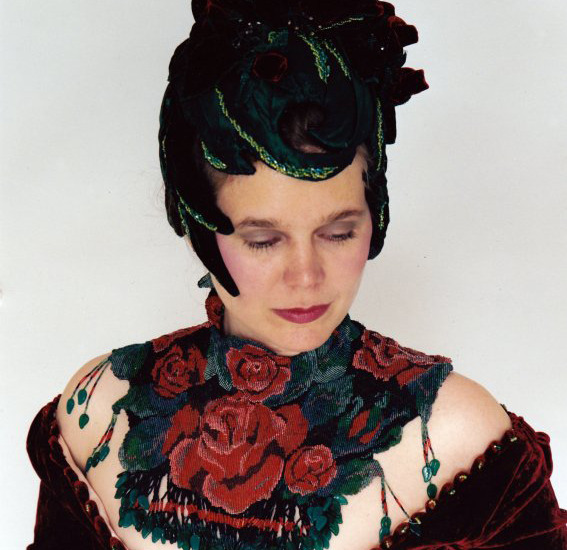

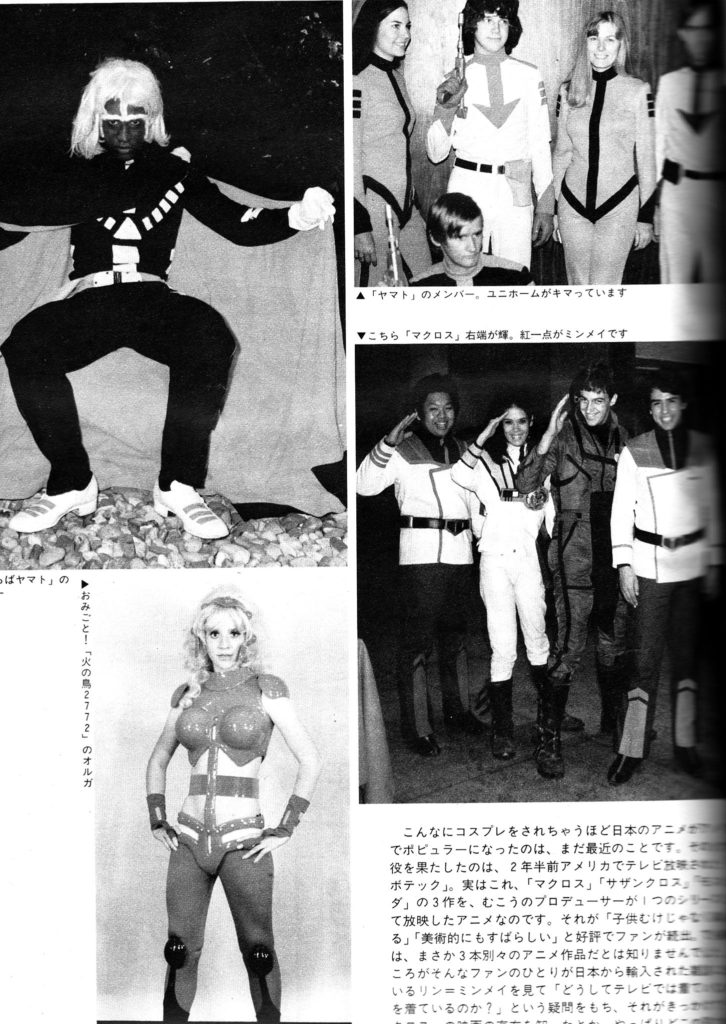
As one of those who are the “dead”, this was beautifully written. My compliments on codifying briefly what has gone on. And, on the rare occasion I show up at a convention, I’m a “costumer”, thank you very much. Because I was there and doing it while the current generation of cosplayer’s parents probably hadn’t yet met. I’m proud to be a “costumer”, and am definitely not a “cosplayer”.
And get out of my sewing room.
Compliments on this excellent summary of fannish history.
I remember NOT seeing the 1984 Worldcon masquerade. I was assigned to help with site selection vote counting, and as much time as we were taking, we kept hearing the masquerade was still in progress. Vote counting ran longer so I missed the whole thing. Fortunately, there is the video.
Sounds like someone’s upset that costuming is more accessible than ever before.
ten you did not get the point of the text your loss sorry hug
No. Someone is upset at being shunted aside & re-branded by people doing something distinctly different than what she does.
Can you give an example of what cosplayers are doing now is different than what costumers have been doing? I don’t think there is any.
The best article I’ve ever seen on the subject of the “cosplay” term and how it has grown to overtake the hobby and why some of us aren’t thrilled about it. Even those who prefer the term “cosplay” to “costuming” must admit, the piece is well written and researched, and it is the most complete history of this topic ever offered. Well done.
I remember those days with great fondness and longing. It has been over 20 years since I competed, but I still miss being a “costumer”! The economy played a huge role in my departure, and while I spent some time costuming in the theater it simply isn’t the same. But there are always the memories – and those boxes in the back room…:)
Pingback: Pixel Scroll 10/4/16 But With Strange Pixels Even Scrolls May File | File 770
As a Costume Technologist, with a Master of Fine Arts in Costume Technologies, I find this a very interesting article. I have friends who self-identify as cosplayers, but never do Anime. Disney characters, Marvel Universe, Sci-fi, but never Anime specific. I never knew the history of the name cosplay.
I also get students who take the Costume Practicum (lab class, no lecture) at the University where I work, who are cosplayers, and what they really want is help and advice on how the make this really complicated Anime outfit from a slightly fuzzy screen shot. What they don’t want to do is take the *actual* Costume Technology classes that would teach them the basis of sewing and draping that would make their hobby an easier proposition. They see those TV shows about cosplay costume competitions and think it is all easy. (Stretch fabric is not easy!) I am always happy to teach someone when they want to learn in a class setting, but I get tired of the “can you just show me how to (insert thing I learned in 3 years of grad school)”.
You know, the fun thing about language is that it evolves.
Costuming never stopped being costuming just because at some point people started calling it cosplay. The supportive, enthusiastic atmosphere within the “early” costuming community you so glowingly described is experienced by young cosplayers at anime and comic book conventions all over the world. Sure, having the internet around has made things more accessible, but hasn’t cheapened anything or made people any less passionate about the time and money they’ve invested in their creations.
I entered costuming as a fifteen year old cosplayer at Anime Expo in the early 2000s. I found it to be a welcoming and inclusive space. While I’ve not been immune to the cattiness and snark that tends to accompany the dark corners of any hobby, I never encountered any of the kind of gatekeeping that you are displaying in this post simply because people have the temerity to call costuming by a different name. Costuming itself really hasn’t changed. What’s popular may have, sure, but at its heart we’re all just nerdy people who like sewing impractical things.
So who are you to judge?
I remember the growth of costuming. You’re correct there’s a distinction between the two, and no need for animosity. They’re different presentations of art.
I should scan in some of my old prints from the 80s, of Jessica Rabbit being guarded by USCM Marines, and Judge Dredd escorting Catwoman.
Call me a grouchy old man, but the word Cosplay was adapted from the Anime costumers in Japan. If your not a character from Japanese culture (pop or traditional) you’re not a cosplayer, you’re a costumer.
As part of the “young” you describe – and also my own creator of anything I cosplay, I see your point, but please also see ours. We (my generation’s cosplay community) have different distinctions in our works. There are the cosplayers who curate – ie. buy everything or commission; and the cosplayers who create – those who make 90% or more of their costume (because really – those wigs are ridiculous and I just want to sew). There are armorworkers, leatherworkers, seamsters, prop makers, wigworkers, and a host of other specialties – because we’ve decided to master our chosen craft.
While the history is interesting, to deride the works of the younger generation simply because we have multiple ways to do the same thing is unfair to the creators. We hone our skill and talents just as much as the “dead” and run into this issue often in convention settings. I can’t tell you how many times I’ve been asked who I commissioned from by those who are older and more established in the field, and frankly it’s both insulting and complimenting – like I’m too young to do that well, but I could never hope for that level of skill even though I’m the same age as the “dead” when they were at my level.
Cosplay is inclusive, just as the art should be. It’s about bringing together those from all over and showing your skills in which ever way you wish to present them. It has expanded the art of costuming beyond what it could ever be – creating a social environment that all can appreciate and involve themselves. It’s about creating new ways of passing on the art and teaching others – like many of the younger creators do. We meet up 2-4 times a month to work on our cosplays together, using each others given expertise to better ourselves. We are collaborative, creative, and dedicated. We intend to pass on the art – but like all things, in an evolving way.
It’s interesting to read that you think I disparage those who use the term “cosplay”. I don’t think I ever said that. The cosplay makers are producing some absolutely stunning work. Costuming is inclusive. It always has been. It’s one of the reasons we were drawn to it. We worked to expand that community, and inclusiveness. We wanted to be sure ALL skill levels would feel comfortable competing on stage, because like some of the younger set’s work, some of ours was also very intimidating to the newer costumers.
The term “cosplay” is simply rebranding what we have been doing for 50 years. We started the International Costumer’s Guild to further the costuming community. There are still chapters all over the country. It was always all about community. We had already expanded the art. There is at least one coffee table book to prove that. The re-branding of costuming came from someone not understanding what he was seeing, and trying to describe it, with limited success. None of us thought of what we did as “playing”. We were makers, and we stayed in character just like you do, but “play” does not feel right to us.
The issue with switching to the term “cosplay”is that the definition is all over the place. Sometimes its just anime. Sometimes it’s those that buy costumes. Sometimes it’s makers too. The old school folks were drawn to the art because they wanted to create. Conflating makers and models is a problem for us. We never allowed purchased costumes in competition. In fact we added workmanship to our competitions to encourage the art of making. My intent was to make a statement about identity. Just as you see yourselves as cosplayers, we see ourselves as costumers. Our identity is as firmly set as yours.
Pingback: Otaku Links: A sign of the times
Disparaged? No way. Skill is skill. Talent is talent.
I was in the 1984 Worldcon Masquerade, and won “Best of Show for Recreation by a Group,” (much to my surprise, as there was no division system at that time for re-creations!)
Here’s my website of the two-year project, how it was done, what happened at the convention, and how I met Jim Henson the following year:
https://www.dark-crystal-tribute.com
I’m not “dead” by any means! I’m still alive, kicking, and involved with photography, web design, writing, and yes, costuming! I taught classes at the 2018 Costume College, and also at Costume Con 36. There were several of us there that had attended Costume Con 1!
I’m waiting for the Costume.org website to re-institute and open their costume archives, as I have years (starting in 1973) of costume photos. They’re in the testing phase right now, and have some of their collection up (including the infamous peanut butter costume!).
Their website for the photo gallery is: https://icggallery.org/
Happy costume…oh, sorry, cosplay!
Thank you Carl!